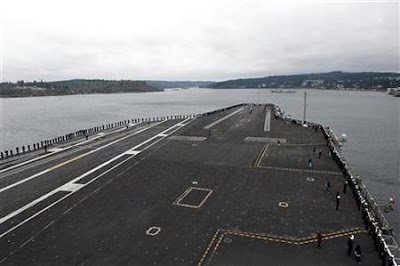

| Visitors Now: | |
| Total Visits: | |
| Total Stories: |
U.S. sends aircraft carrier back to Gulf to face Iran, Syria
Monday, August 27, 2012 9:31
% of readers think this story is Fact. Add your two cents.
Reuters
Daniel Fineren
Daniel Fineren
(Reuters) – The U.S. Navy is cutting short home leave for the crew of one of its aircraft carriers and sending them back to the Middle East next week to counter any threat from Iran, according to the official Navy News Service.
Defence Secretary Leon Panetta told sailors aboard the USS Stennis in their home port of Seattle on Wednesday they were needed back in the Middle East soon, after approving calls from the U.S. Central Command for Stennis to return to the region.
“Obviously, Iran is one of those threats,” the U.S. military news service quoted Panetta as saying during a send-off event at a military base on the U.S. West Coast.
“Secondly, it is the turmoil in Syria,” he said. “We’re obviously following that closely as well.”
The Stennis’ departure in January from the Bahrain-based U.S. Fifth Fleet area of operations prompted Iranian army chief Ataollah Salehi to threaten action if it returned, saying Iran was “not in the habit of warning more than once”.
The threats started a war of words between Iran and the United States that spooked oil markets, and fears over possible military confrontation remain high.
Panetta cited Iran’s nuclear program and its threats to oil tankers in the Strait of Hormuz as two concerns the Stennis strike group could counter in the U.S. Central Command’s area of responsibility, which also includes Syria and Afghanistan.
U.S. attention on Syria is focused on providing humanitarian aid, monitoring chemical and biological weapon stockpiles, and offering non-lethal assistance to forces opposing President Bashar al-Assad, he said.
A spokesman for the Fifth Fleet in Bahrain said the redeployment was not a build-up in the Gulf because the USS Enterprise is due to leave the region on its final voyage back to the United States before being decommissioned after over 50 years of service.
“The presence of two aircraft carriers changes based on needs and requirements,” Lieutenant Greg Raelson said.
Iranian threats to block the waterway through which about 17 million barrels a day sailed in 2011 have grown in the past year as U.S. and European sanctions aimed at starving Tehran of funds for its nuclear program have tightened.
A heavy western naval presence in the Gulf is a big deterrent to Tehran actually trying to block the shipping route through which most of the crude exported from Saudi Arabia, the United Arab Emirates, Kuwait and Iraq sails.
The Stennis had been due to deploy next to the Pacific towards the end of 2012 but its return to active duty has been brought forward by four months because of tension in the Gulf.
(Reporting by Daniel Fineren; Editing by Angus MacSwan)
Help Us Transmit This Story
The
Intercept is a collection and transmission of data that offers
substantive contradictions, challenges and enlightenment over the
conventional drivel brought to us by corporate media.
2012-08-27 09:29:17
Source: http://weeklyintercept.blogspot.com/2012/08/us-sends-aircraft-carrier-back-to-gulf.html
Source:




